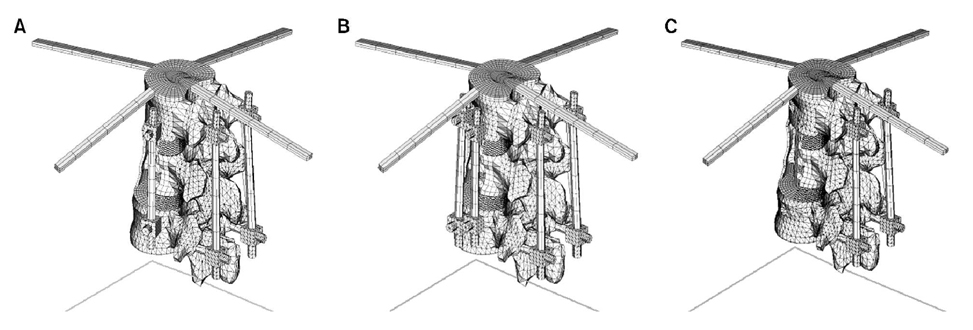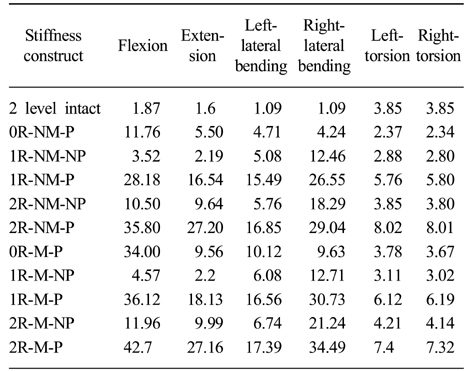Articles
- Page Path
- HOME > J Musculoskelet Trauma > Volume 20(1); 2007 > Article
-
Original Article
- Biomechanical Efficacy of Various Anterior Spinal Fixation in Treatment of Thoraco-lumbar Spine Fracture
- Ye-Soo Park, M.D., Hyoung-Jin Kim, M.D., Choong-Hyeok Choi, M.D., Won-Man Park, Yoon-Hyuk Kim, Ph.D.
-
Journal of the Korean Fracture Society 2007;20(1):70-75.
DOI: https://doi.org/10.12671/jkfs.2007.20.1.70
Published online: June 14, 2016
Department of Orthopaedic Surgery, Guri Hospital, Hanyang University College of Medicine, Seoul, Korea.
*Department of Orthopaedic Surgery, Hanyang University College of Medicine, Seoul, Korea.
†School of Advanced Technology, Kyung Hee University, Seoul, Korea.
- Address reprint requests to: Yoon-Hyuk Kim, Ph.D. School of Advanced Technology, Kyung Hee University, 1, Seochondong, Giheung-gu, Yongin 449-701, Korea. Tel: 82-31-201-2028, Fax: 82-31-202-8106, yoonhkim@khu.ac.kr
Copyright © The Korean Fracture Society. All rights reserved
- 731 Views
- 3 Download
- 1 Crossref
Abstract
-
Purpose
- To evaluate the biomechanical results according to various anterior spinal fixation methodology in the treatment of thoracolumbar spine fracture.
-
Materials and Methods
- The comparative analysis of fixation method was evaluated by three dimensional finite element model using the 1 mm reconstruction image of CT. Authors evaluated the flexion, extension, lateral bending, torsional stresses with 12 fixation methods for the compression and burst fracture.
-
Results
- In biomechanical analysis, stiffness of body-fixation device was more stable in two-rod system in compression fracture and was stable in one-rod, two-rod system in burst fracture, but two-rod system was showed over-increase of stiffness.
-
Conclusion
- Authors recommend the usage of two-rod system in anterior fixation only and anterior one-rod system in anterior-posterior fixation.
- 1. An HS, Vaccaro A, Cotler JM, Lin S. Low lumbar burst fractures. Comparison among body cast, Harrington rod, Luque rod, and Steffee plate. Spine (Phila Pa 1976), 1991;16:Suppl 8. S440-S444.
- 2. Been HD. Anterior decompression and stabilization of thoracolumbar burst fractures by the use of the Slot-Zielke device. Spine, 1991;16:70-77.Article
- 3. Been HD, Bouma GJ. Comparison of two types of surgery for thoraco-lumbar burst fractures: combined anterior and posterior stabilisation vs. posterior instrumentation only. Acta Neurochir (Wien), 1999;141:349-357.ArticlePDF
- 4. Carl AL, Tranmer BI, Sachs BL. Anterolateral dynamized instrumentation and fusion for unstable thoracolumbar and lumbar burst fractures. Spine (Phila Pa 1976), 1997;22:686-690.Article
- 5. Choi IS, Kim WI, Lim S, Lee SH. Treatment of unstable fracture of the thoracolumbar spine using Kaneda instrumentation. J Korean Fract Soc, 1994;7:192-200.Article
- 6. Denis F, Armstrong GW, Searls K, Matta L. Acute thoracolumbar burst fractures in the absence of neurological deficit. A comparison between operative and nonoperative treatment. Clin Orthop Relat Res, 1984;189:142-149.
- 7. Dewald RL. Burst fractures of the thoracic and lumbar spine. Clin Orthop Relat Res, 1984;189:150-161.Article
- 8. Ebelke DK, Asher MA, Neff JR, Kraker DP. Survivorship analysis of VSP spine instrumentation in the treatment of thoracolumbar and lumbar burst fractures. Spine (Phila Pa 1976), 1991;16:Suppl 8. S428-S432.Article
- 9. Edwards CC, Levine AM. Early rod-sleeve stabilization of the injured thoracic and lumbar spine. Orthop Clin North Am, 1986;17:121-145.Article
- 10. Goel VK, Ramirez SA, Kong W, Gilbertson LG. Cancellous bone Young's modulus variation within the vertebral body of a ligamentous lumbar spine - application of bone adaptive remodeling concepts. J Biomech Eng, 1995;117:266-271.
- 11. Gurr KR, McAfee PC, Shih CM. Biomechanical analysis of anterior and posterior instrumentation systems after corpectomy. A calf-spine model. J Bone Joint Surg Am, 1988;70:1182-1191.Article
- 12. Gurwitz GS, Dawson JM, McNamara MJ, Federspiel CF, Spengler DM. Biomechanical analysis of three surgical approaches for lumbar burst fractures using short-segment instrumentation. Spine (Phila Pa 1976), 1993;18:977-982.Article
- 13. Kaneda K, Abumi K, Fujiya M. Burst fractures with neurologic deficits of the thoracolumbar-lumbar spine. Results of anterior decompression and stabilization with anterior instrumentation. Spine (Phila Pa 1976), 1984;9:788-795.Article
- 14. Kaneda K, Taneichi H, Abumi K, Hashimoto T, Satoh S, Fujiya M. Anterior decompression and stabilization with the Kaneda device for thoracolumbar burst fractures associated with neurological deficits. J Bone Joint Surg Am, 1997;79:69-83.Article
- 15. Kim JO, Kang OY, Kang CN, Ahn SY. The comparison of conservative treatment with operative treatment in bursting fracture. J Korean Fract Soc, 1995;8:807-814.
- 16. Kostuik JP. Anterior fixation for fractures of the thoracic and lumbar spine with or without neurologic involvement. Clin Orthop Relat Res, 1984;189:103-115.Article
- 17. Lu YM, Hutton WC, Gharpuray VM. Do bending, twisting and diurnal fluid changes in the disc affect the propensity to prolapse? A viscoelastic finite element model. Spine (Phila Pa 1976), 1996;21:2570-2579.Article
- 18. McDonough PW, Davis R, Tribus C, Zdeblick TA. The management of acute thoracolumbar burst fractures with anterior corpectomy and Z-plate fixation. Spine (Phila Pa 1976), 2004;29:1901-1908.Article
- 19. McLain RF, Sparling E, Benson DR. Early failure of short-segment pedicle instrumentation for thoracolumbar fractures. A preliminary report. J Bone Joint Surg Am, 1993;75:162-167.Article
- 20. Natarajan RN, Andersson GB. The influence of lumbar disc height and cross-sectional area on the mechanical response of the disc to physiologic loading. Spine (Phila Pa 1976), 1999;24:1873-1881.Article
- 21. Olerud S, Karlstrom G, Sjostrom L. Transpedicular fixation of thoracolumbar vertebral fractures. Clin Orthop Relat Res, 1988;227:44-51.Article
- 22. Payer M. Unstable burst fractures of the thoraco-lumbar junction: treatment by posterior bisegmental correction/fixation and staged anterior corpectomy and titanium cage implantation. Acta Neurochir (Wien), 2006;148:299-306.ArticlePDF
- 23. Pflugmacher R, Schleicher P, Schaefer J, et al. Biomechanical comparison of expandable cages for vertebral body replacement in thoracolumbar spine. Spine (Phila Pa 1976), 2004;29:1413-1419.
- 24. Polikeit A, Ferguson SJ, Nolte LP, Orr TE. Factors influencing stresses in the lumbar spine after the insertion of intervertebral cages: finite element analysis. Eur Spine J, 2003;12:413-420.ArticlePDF
- 25. Schreiber U, Bence T, Grupp T, et al. Is a single anterolateral screw-plate fixation sufficient for the treatment of spinal fractures in the thoracolumbar junction? A biomechanical in vitro investigation. Eur Spine J, 2005;14:197-204.ArticlePDF
- 26. Whitesides TE Jr. Traumatic kyphosis of the thoracolumbar spine. Clin Orthop Relat Res, 1977;128:78-92.Article
- 27. Wood KB, Bohn D, Mehbod A. Anterior versus posterior treatment of stable thoracolumbar burst fractures without neurologic deficit: a prospective, randomized study. J Spinal Disord Tech, 2005;18:S15-S23.
- 28. Zhong ZC, Wei SH, Wang JP, Feng CK, Chen CS, Yu CH. Finite element analysis of the lumbar spine with a new cage using a topology optimization method. Med Eng Phys, 2006;28:90-98.Article
REFERENCES
The finite element models of thoracolumbar spine segments with different anteroposterior fixation techniques were developed.

All datas of stiffness in construct varieties (Nm/°)

0R-NM-P: 0 rod - no midcolumn decompression - pedicle screw instrumentation, 1R-NM-NP: 1 rod - no midcolumn decompression - no pedicle screw instrumentation, 1R-NM-P: 1 rod - no midcolumn decompression - pedicle screw instrumentation, 2R-NM-NP: 2 rod - no midcolumn decompression - no pedicle screw instrumentation, 2R-NM-P: 2 rod - no midcolumn decompression - pedicle screw instrumentation, 0R-M-P: 0 rod - midcolumn decompression - pedicle screw instrumentation, 1R-M-NP: 1 rod - midcolumn decompression - no pedicle screw instrumentation, 1R-M-P: 1 rod - midcolumn decompression - pedicle screw instrumentation, 2R-M-NP: 2 rod - midcolumn decompression - no pedicle screw instrumentation, 2R-M-P: 2 rod - midcolumn decompression - pedicle screw instrumentation.
Figure & Data
REFERENCES
Citations

- Lumbar Spine Fracture
Seung-Wook Back, Hyun-Joong Cho, Ye-Soo Park
Journal of the Korean Fracture Society.2011; 24(3): 277. CrossRef

Fig. 1
All datas of stiffness in construct varieties (Nm/°)
0R-NM-P: 0 rod - no midcolumn decompression - pedicle screw instrumentation, 1R-NM-NP: 1 rod - no midcolumn decompression - no pedicle screw instrumentation, 1R-NM-P: 1 rod - no midcolumn decompression - pedicle screw instrumentation, 2R-NM-NP: 2 rod - no midcolumn decompression - no pedicle screw instrumentation, 2R-NM-P: 2 rod - no midcolumn decompression - pedicle screw instrumentation, 0R-M-P: 0 rod - midcolumn decompression - pedicle screw instrumentation, 1R-M-NP: 1 rod - midcolumn decompression - no pedicle screw instrumentation, 1R-M-P: 1 rod - midcolumn decompression - pedicle screw instrumentation, 2R-M-NP: 2 rod - midcolumn decompression - no pedicle screw instrumentation, 2R-M-P: 2 rod - midcolumn decompression - pedicle screw instrumentation.
0R-NM-P: 0 rod - no midcolumn decompression - pedicle screw instrumentation, 1R-NM-NP: 1 rod - no midcolumn decompression - no pedicle screw instrumentation, 1R-NM-P: 1 rod - no midcolumn decompression - pedicle screw instrumentation, 2R-NM-NP: 2 rod - no midcolumn decompression - no pedicle screw instrumentation, 2R-NM-P: 2 rod - no midcolumn decompression - pedicle screw instrumentation, 0R-M-P: 0 rod - midcolumn decompression - pedicle screw instrumentation, 1R-M-NP: 1 rod - midcolumn decompression - no pedicle screw instrumentation, 1R-M-P: 1 rod - midcolumn decompression - pedicle screw instrumentation, 2R-M-NP: 2 rod - midcolumn decompression - no pedicle screw instrumentation, 2R-M-P: 2 rod - midcolumn decompression - pedicle screw instrumentation.

 E-submission
E-submission KOTA
KOTA TOTA
TOTA TOTS
TOTS
 Cite
Cite

